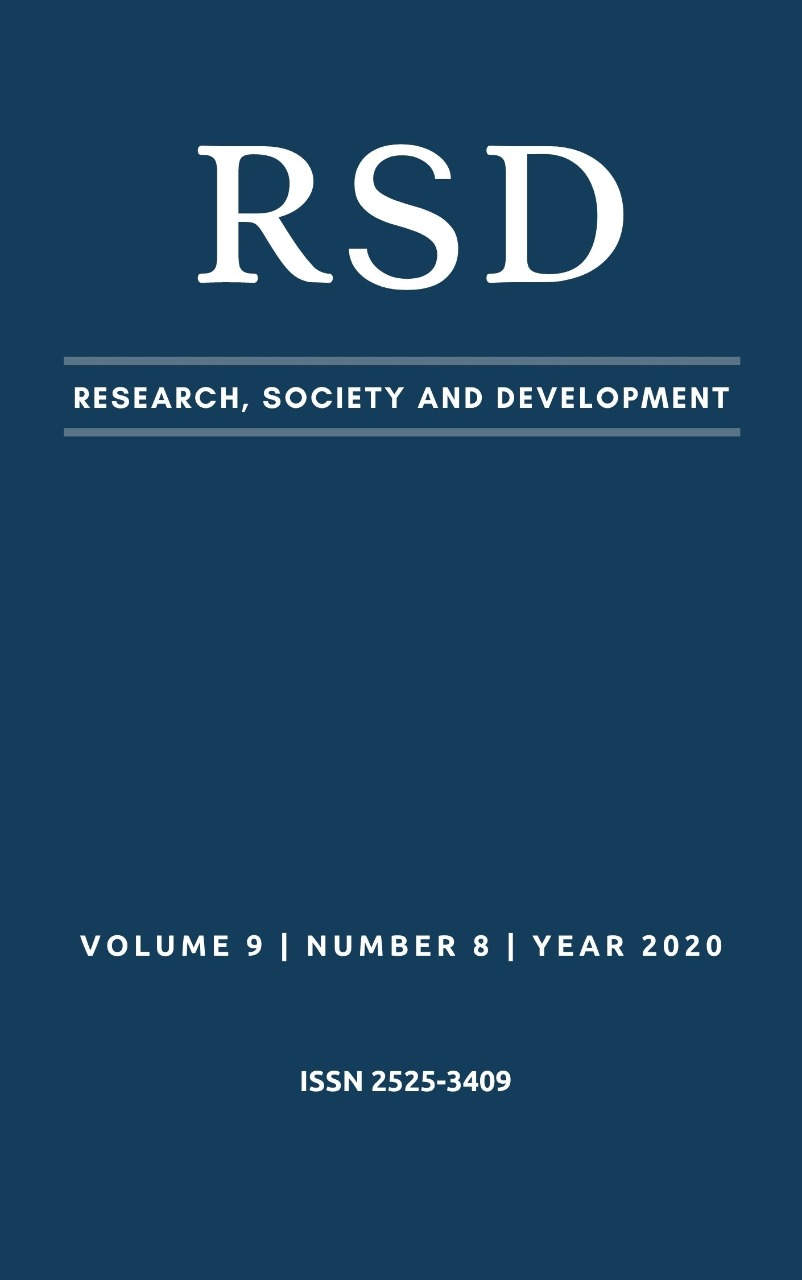Rehabilitación estética con carillas prefabricadas de resina compuesta: reporte de caso
DOI:
https://doi.org/10.33448/rsd-v9i8.5728Palabras clave:
Coronas con Frente Estético, Fracaso de la Restauración Dental, Estética Dental.Resumen
Introducción: La armonía facial depende de la disposición, alineación y posición de los dientes, que, cuando están en una geometría apropiada, traducen la expresión de lo que es hermoso. Uno de los problemas encontrados es el desequilibrio en la armonía de la sonrisa causado por los cambios promovidos por los bordes incisales fracturados, la mala posición dental, los diastemas, entre otros. En este sentido, aparecieron en el mercado facetas de resina compuesta prefabricadas, como los laminados compuestos prepolimerizados, para simplificar el procedimiento de restauración y permitir la estética y la armonía de la sonrisa. Objetivo: Describir el uso de carillas de resina prefabricadas en rehabilitación estética previa. Informe del caso: Paciente, mujer, 46 años, asistió a la clínica dental 42 años, mujer, asistió a la Clínica Integrada de la Facultad de Odontología de la UFRJ quejándose de la estética de su sonrisa. En el examen clínico, se observó tinción y mala restauración en los dientes 11 y 21, además de la presencia de diastema. El plan de tratamiento consistió en utilizar las facetas prefabricadas de resina compuesta, acondicionamiento ácido y adhesivo, de acuerdo con las recomendaciones del fabricante. Conclusión: El uso de carillas permite un alto estándar estético en dientes anteriores a través de una técnica mínimamente invasiva. Como se describe en este informe de caso, tiene una gran aplicabilidad clínica y facilidad para realizar la técnica restauradora.
Referencias
Ahmad, I. (2010). Risk management in clinical practice. Part 5. Ethical considerations for dental enhancement procedures. British Dental Journal. 209, 207-214.
Bagis, B. & Turgut, S. (2013). Optical properties of current ceramics systems for laminate veneers. Journal of dentistry. 14, 24 -30.
Campos, P. R. B., Mala, R. R., Menezes, L. R., Barbosa, I. F., Cunha, A. C. & Pereira, G. D. S. (2015). Rubber dam isolation – Key to success in diastema closure technique with direct composite. The International Journal oh Esthetic Dentistry. 10, 564-572.
Dietschi, D. & Devigus A. (2011). Prefabricated composited Veneers: Historical Perspective, Indications and Clinical application. The European Journal of Esthetic Dentistry. 6, 2-11.
D'Onofre, P. L., Câmara, J. V. F., de Paiva, R. V., Pereira, G. D. S. & Capillé, C. L. (2020). Direct composite resin veneer as a minimally invasive restorative technique for harmonizing the smile. Research, Society and Development. 9(8), 1-18.
D´Souza, D. S. D. & Kumar, C. O. L. (2010). Esthetics and biocompatibility of Composite Dental Laminates. MJAFI. 66(3), 239-243.
Gomes, G. & Perdigão, J. (2014). Prefabricated Composite Resin Veneers – A clinical Review. Journal of Esthetic and Restorative Dentistry. 26, 302-303.
Joiner, A. (2006). The bleaching of teeth: A Review of the literature. Journal of Dentistry. 3, 412-419.
Korkut, B., YaniKoglu, F. & Gunday, M. (2013). Direct composite laminate veneers: Three Case Reports. Journal of Dental Research, Dental Clinics, Dental Prospects. 7, 105-111.
Lin, T., Liu, P., Ramp, L. C, Essig, M. E., Givan, D. A. & Pan, Y. (2012). Fracture Resistance and marginal discrepancy of porcelain laminate veneers influenced by preparation desing and restorative material in vitro. Journal of dentistry. 40, 202-209.
Novelli, C. (2015). Esthetic Treatment of a Periodontal Patient with Prefabricated Composited Veneers and Fiber – Reinforced Composite: Clinical Considerations and Technique. Journal of Esthetic and Restorative Rentistry. 27, 4-12.
Perdigão, J., Sezinando, A., Muñoz, M. A., Martinez, I. V. L. & Lougercio, A. D. (2013). Prefabricated Veneers – Bond Strengths and Ultramorphological Analyses. The Journal of adhesive dentistry. 15, 1-10.
Peumans, M. Meerbeek, B. V., Lambrechts, P. & Vanherle, G. (2000). Porcelain veneers: a reveiew of the literature. Journal of Dentistry. 28, 163-167.
Rosa, F. M., Hammerschimitt, T., Zanchet, M. & Pozzobon, R. (2007). A importância do enfoque multidisciplinar no recontorno estético de diastemas e incisivos conoides. Clinica. J. Braz. Dent. 3, 42-28.
Sharma P. K. & Sharma, P. (2012). Dental Smile Esthetics: The Assement and Creation of the Ideal Smile. Seminars in Ortodontics. 3(3), 193-201.
Sperduto, C. M., Cavalcante, J. B. S., de Santana, N. G., Câmara, J. V. F., Barbosa, I. F. & Pereira, G. D. S. (2019). Aesthetic recovery of the smile using a simple and effective application of prepolymerized composite veneers. Rio de Janeiro Dental Journal. (4)2, 67-71.
Tiltey, K. C., Torneck, C. D., Smith, D. C. & Adibfar, A. (1998). Adhesion of composite Resin to Bleached and Unbleached Bovine Enamel. J Dent Res. 67(12), 1523-1528.
Wolff, D., Kraus, T., Schach, C., Pritsch, M., Mente, J., Staehle, H. J. & Ding, P. (2010). Recontouring teeth and closing diastemas with direct composite buildups: A clinical evaluation of survival and quality parameters. Journal of Dentistry. 38, 1001-1009.
Descargas
Publicado
Número
Sección
Licencia
Derechos de autor 2020 Lidiane Bastos, Ericles Otávio Santos, João Victor Frazão Câmara, Daniela Luzimar Claudino, Paulo Ricardo Barros de Campos, Isabel Ferreira Barbosa, Gisele Damiana da Silveira Pereira

Esta obra está bajo una licencia internacional Creative Commons Atribución 4.0.
Los autores que publican en esta revista concuerdan con los siguientes términos:
1) Los autores mantienen los derechos de autor y conceden a la revista el derecho de primera publicación, con el trabajo simultáneamente licenciado bajo la Licencia Creative Commons Attribution que permite el compartir el trabajo con reconocimiento de la autoría y publicación inicial en esta revista.
2) Los autores tienen autorización para asumir contratos adicionales por separado, para distribución no exclusiva de la versión del trabajo publicada en esta revista (por ejemplo, publicar en repositorio institucional o como capítulo de libro), con reconocimiento de autoría y publicación inicial en esta revista.
3) Los autores tienen permiso y son estimulados a publicar y distribuir su trabajo en línea (por ejemplo, en repositorios institucionales o en su página personal) a cualquier punto antes o durante el proceso editorial, ya que esto puede generar cambios productivos, así como aumentar el impacto y la cita del trabajo publicado.


